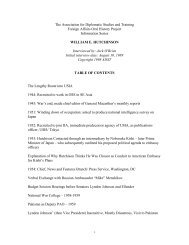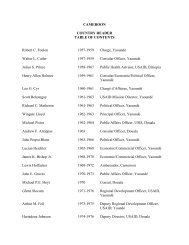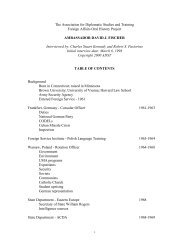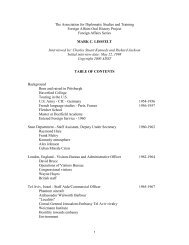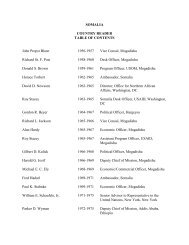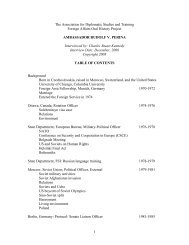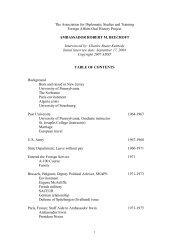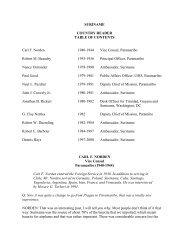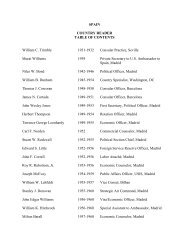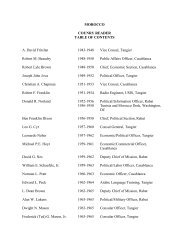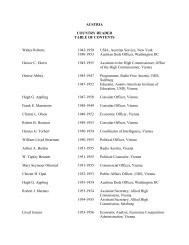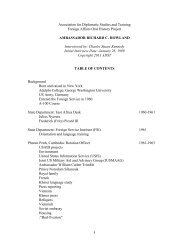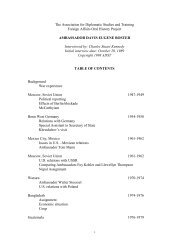1 The Association for Diplomatic Studies and Training Foreign ...
1 The Association for Diplomatic Studies and Training Foreign ...
1 The Association for Diplomatic Studies and Training Foreign ...
Create successful ePaper yourself
Turn your PDF publications into a flip-book with our unique Google optimized e-Paper software.
its history <strong>and</strong> was a patriot in the full sense of the word. He was a part of Persian history,<br />
certainly Persian cultural history, <strong>and</strong> was very sensitive to current political movements<br />
<strong>and</strong> attitudes. Being a poet himself, he was closely in touch with the fellow dissident<br />
poets, the poets of the left, who tended to write what they called the “new poetry” – that<br />
is, they created new <strong>for</strong>ms of poetry, writing not in the ghazals <strong>and</strong> the <strong>for</strong>mal structures<br />
of the past, but free verse, so to speak. <strong>The</strong> subject matter was very direct <strong>and</strong><br />
contemporary, a kind of realism at work. Through Sepenta I met the poets <strong>and</strong><br />
antiquarians <strong>and</strong> historians, politicians, <strong>and</strong> musicians, <strong>and</strong> those in the theater of which<br />
there was a very interesting kind in Isfahan, as well as many of the religious people. I met<br />
most of the leading mullahs (Islamic clerics) in Isfahan, of all kinds, ranging from the<br />
most conservative to the various Sufi sects.<br />
In fact, one of the very first official occasions I attended in Isfahan at the suggestion of<br />
Sepenta was a funeral in the mosque which was down the street from the consulate on the<br />
Chaharbagh, the main, ceremonial street of Isfahan. <strong>The</strong> Chabar Bagh (four gardens) was<br />
built in the time of the Safavids, in the 16 th century. It has water courses down the middle<br />
of a broad avenue, with eight rows of chenar, which is a kind of plane tree, ancient plane<br />
trees including some that were planted in the time of the Safavids, a very beautiful<br />
avenue. <strong>The</strong> funeral was <strong>for</strong> a poet who had just died. He was a re<strong>for</strong>mist poet. I can<br />
recall it very well because I had no idea what to expect. It turned out to be a most<br />
courteous moving event at which I was given a place of honor, served a cup of coffee,<br />
bitter coffee, <strong>and</strong> a cigarette. <strong>The</strong> mullahs were reciting suras (chapters) from the Koran,<br />
Sufi poetry, <strong>and</strong> declaiming about the life of the deceased poet. It was an auspicious<br />
beginning I thought, this very first official act I did in Isfahan. <strong>The</strong> word got around<br />
Isfahan that I had gone to the mosque. Sepenta knew what he was doing in suggesting<br />
going to events like this funeral. It was clearly the right kind of introduction, the right first<br />
step.<br />
Q: I’d like to step back. Where in 1959 did Isfahan fit into the Iranian body politic, <strong>and</strong><br />
what was going on in Iran at that time?<br />
MILLER: Well, Isfahan is in the middle of this very large country, Iran. Tehran is up in<br />
the north, eight hours by car. It’s about 500 miles, one hour by plane. It’s the second city<br />
in size in Iran – it was then, <strong>and</strong> it is now. It was the capital from the 16 th century until the<br />
19 th century, <strong>and</strong> anyone with any sense would still put the capital there, in the center of<br />
the country rather than Tehran. It has sufficient water <strong>and</strong> the climate is excellent, ideal,<br />
but <strong>for</strong> political reasons the Qajars, the successor dynasty to the Safavids, established<br />
their capital in Tehran, to the north.<br />
At that time, Iran was organized into ten ostans as they were called in Persian, ten states.<br />
Each state was governed by a governor called an Ost<strong>and</strong>ar, <strong>and</strong> each subsection of states,<br />
several counties or the equivalent would be under the governance of a Farm<strong>and</strong>ar who<br />
reported to the Ost<strong>and</strong>ar. <strong>The</strong>n there was a mayor, Shahrdar in the case of Isfahan, who<br />
was elected. This was from the time of the Constitution in 1905. <strong>The</strong> mayors were<br />
elected. This was an underst<strong>and</strong>ing in the 1905 group <strong>and</strong> really, from that time on, that<br />
29




